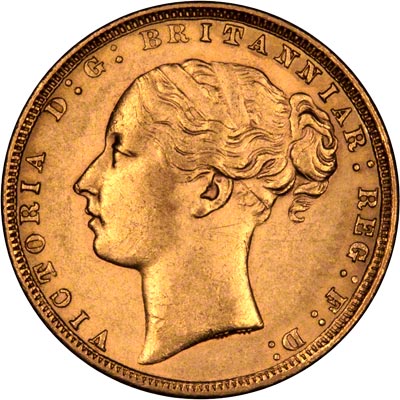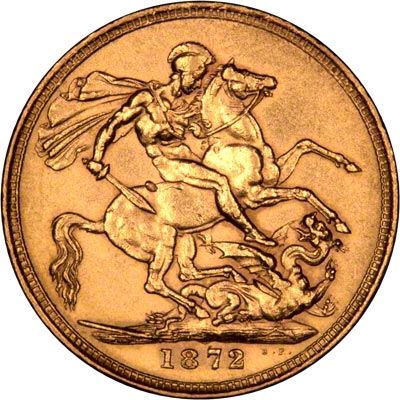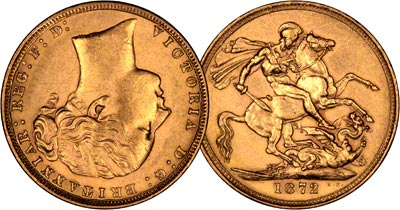| The Very Highest Quality Coins... |
| Upside Down Heads on Coins |
|
 1872 Sovereign with Head Upside Down
|

|
 Reverse of 1872 Shield Sovereign
|
 1872 Victoria Young Head St. George Reverse Sovereign Struck in Coin Alignment
1872 Victoria Young Head St. George Reverse Sovereign Struck in Coin Alignment
|
Almost every day we get asked about coins described as having "the head upside down", or at least the two sides of the coin the wrong way round compared with "normal" coins.
Impossible to have Head Upside Down
It is actually impossible to have a coin with the head upside down. This is because the head side of the coin is defined as the main side or obverse of the coin. The other side is termed the reverse or secondary side of the coin. Because of this it is never the head which is upside down, it is always the reverse which is upside down. For some strange reason, almost everybody finding such a coin describes it as having its head upside down, we don't know why.
Inverted Designs
The positions of the obverse and reverse relative to each other are known as the alignment of the coin. Since the very first coins, it has been quite common for the two sides not to be perfectly aligned with each other, however there are two common alignments, These are known as "coin alignment" and "medal alignment".
Medal Alignment
If you were to place a coin on a flat surface balanced on its edge so that the designs on both sides were the same way round, this is known as medal alignment. Medals are often worn suspended by a swivel at the top, so that they can be turned about their vertical axis. It would be important for both sides of the medal to appear the correct way round, This would not apply to coins.
Coin Alignment
If a coin is similarly placed and both sides of the coins appear upside down compared with each other, this is what is known as coin alignment. It is not important for the two sides of a coin to be aligned in any particular way, as it would be for medals.
It seems to have become more common during the eighteenth century for more coins to be struck in medal alignment than in coin alignment. Because of this, most people have become used to all the coins they see being struck in medal alignment, and they have therefore come to think of this as normal. When they come across a coin which is struck in coin alignment, they think they have found something rare or unusual, and do not stop to think that the particular type of coin was always struck in coin alignment.
Right & Wrong Way Round
If you find a coin which appears to be the "wrong way up", the simplest way to find which is right or wrong would be to find one or two more of the same coin type and compare them. If all the examples you find are the "wrong way up", then obviously this is the normal or right way up for that particular coin. Clearly if all but one are the same way round, the the odd one out really is an error or rarity.
The same applies if you find a coin where the two sides are the "right way up", but all the other examples of that coin type the "wrong way up".
Right and Wrong are Relative
Right and wrong are clearly relative not only to each other.
Normal and abnormal depend on what is more common for that coin type.
Most people's perception is biased by what they are used to seeing, and which they therefore believe is normal.
It Depends on Which Way You Hold Them
Another factor that most people don't realise is that the way the second side of a coin appears when spun depends on how one holds the coin. Because most modern coins are struck in medal alignment, to turn a coin over, most people hold it at the top and bottom. Done this way any coin struck in medal alignment will appear to have both sides the right way round.
In a country or time when most coins were struck in coin alignment, we believe that most people would turn a coin by holding it at both sides, in which case both sides would appear the right way round. A person turning a coin in such a manner would think a modern coin struck in medal alignment had its sides the wrong way round.
English Coins
Most countries have issued coins struck in both main alignments, including Britain and the USA.
The sovereign we picture is a young head sovereign of Queen Victoria. All sovereigns of this type were issued in coin alignment.
American Coins
The United States of America also used to issue most of its coins in coin alignment, so there is nothing unusual in finding an older type of American coin struck this way.
Is Your Coin the Normal Type?
For more information on whether the coin you have was struck in coin or medal alignment, you should compare it with a number of other coins of the same type. If it is an old coin or you do not have access to other coins of the same type, our advice is to get hold of a suitable coin catalogue. If you cannot compare it, assume that it is the normal way for the particular coin type, you will be wrong less than one time in a million.
Coin catalogues are stocked by most libraries, and can be ordered from most bookshops or coin dealers. Which catalogue you need obviously depends on which country your coin was issued by.
Don't Ask
Now you have read this page, we hope you will not phone or e-mail us or other dealers to ask us whether your "inverted" coin is rare!
You may wish to visit some of our other pages:
British Coin Denominations. What's a Groat,? etc.
Common Names of British Coins. What's a Tanner?
Inscriptions on British Coins
Value of my Coin. What's it Worth?
Book Reviews
This section contains reviews of several coin catalogues.
Do you have a query about our coins?
| ...at the Lowest Possible Price |
|
32 - 36 Harrowside, Blackpool, Lancashire, FY4 1RJ, England. Telephone (44) - (0) 1253 - 343081 ; Fax 408058; E-mail: The URL for our main page is: https://24carat.co.uk | Chard(1964) Ltd |